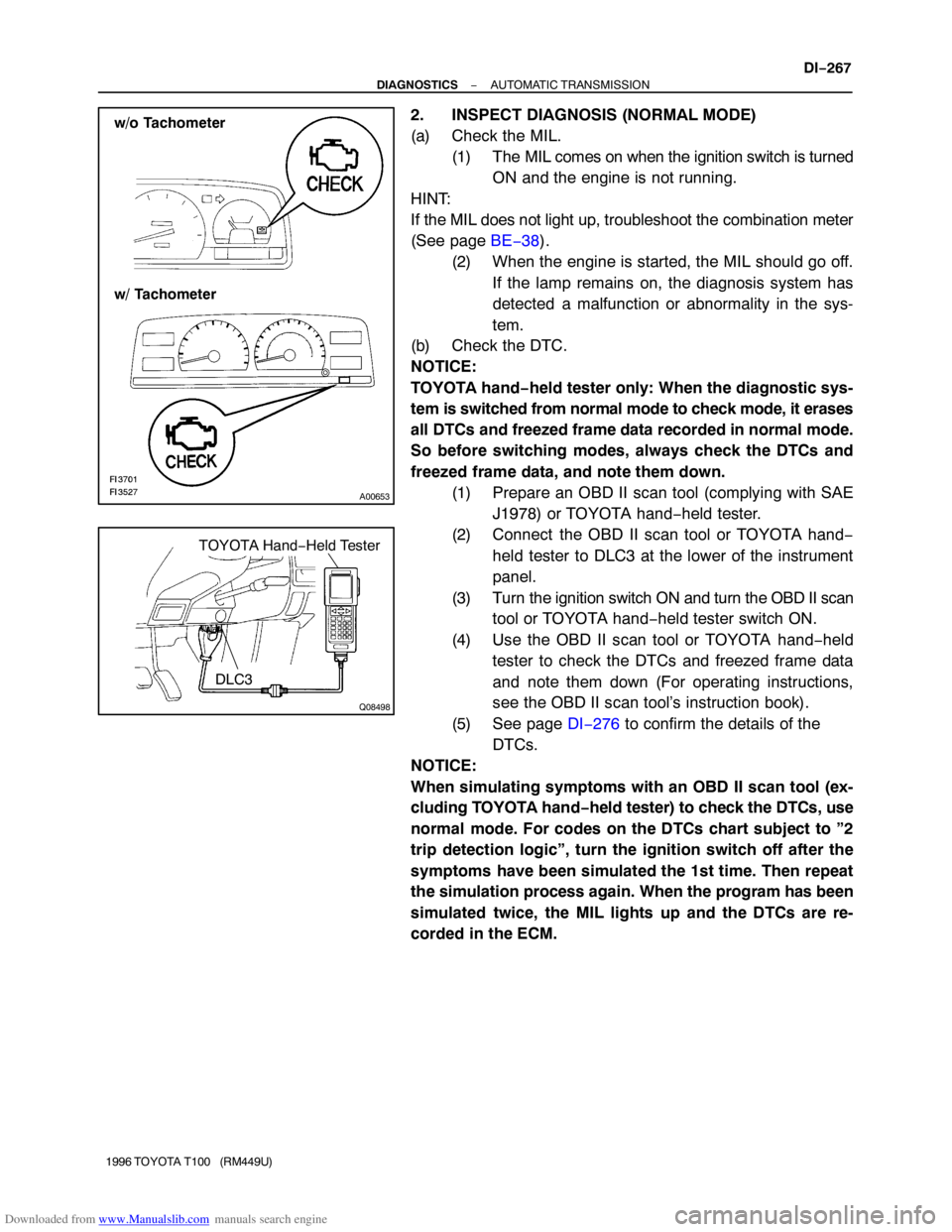Page 524 of 2062

Downloaded from www.Manualslib.com manuals search engine A00687
START3
BE6653P24337P24336
A00773A00789
ON
For M/T
For A/TFC (+)
FC (+)
Fuel Inlet Hose
DI−260
− DIAGNOSTICSENGINE (5VZ−FE)
1996 TOYOTA T100 (RM449U)
8 Check voltage between terminal 3 of circuit opening relay connector and body
ground.
CHECK:
Measure voltage between terminal 3 of circuit opening relay
connector and body ground when engine is cranked.
OK:
Voltage: 9 − 14 V
NG Check for starter signal circuit (See page
DI−248).
OK
Check for open in harness and connector be-
tween terminal 6 of circuit opening relay con-
nector and body ground (See page IN−26).
OBD II scan tool (excluding TOYOTA hand−held tester):
1 Check operation of fuel pump.
PREPARATION:
(a) Remove the right cowl side trim (See page SF−61).
(b) Turn the ignition switch ON.
CHECK:
(a) Connect between terminal FC of ECM connector and
body ground.
(b) Check for fuel pressure in the inlet hose when it is pinched
off.
OK:
There is pressure in the fuel inlet hose.
HINT:
At this time, you will hear a fuel flowing noise.
OK Go to step 7.
NG
Page 525 of 2062
Downloaded from www.Manualslib.com manuals search engine − DIAGNOSTICSENGINE (5VZ−FE)
DI−261
1996 TOYOTA T100 (RM449U)
2 Check for ECM power source circuit (See page DI−251).
NG Repair or replace.
OK
3 Check circuit opening relay (See page DI−255, step 3).
NG Replace circuit opening relay.
OK
4 Check voltage between terminal FC of ECM connector and body ground (See
page DI−255, step 4).
NG Check for open in harness and connector be-
tween EFI main relay and circuit opening relay
and ECM (See page IN−26).
OK
5 Check fuel pump (See page SF−5).
NG Repair or replace fuel pump.
OK
Page 526 of 2062
Downloaded from www.Manualslib.com manuals search engine DI−262
− DIAGNOSTICSENGINE (5VZ−FE)
1996 TOYOTA T100 (RM449U)
6 Check for open in harness and connector between circuit opening relay and fuel
pump, fuel pump and body ground (See page IN−26).
NG Repair or replace harness or connector.
OK
Check and replace ECM (See page IN−26).
7 Check circuit opening relay (See page DI−255, step 7).
NG Replace circuit opening relay.
OK
8 Check voltage between terminal 3 of circuit opening relay connector and body
ground (See page DI−255, step 8).
NG Check for starter signal circuit (See page
DI−248).
OK
Check for open in harness and connector be-
tween terminal 6 of circuit opening relay con-
nector and body ground (See page IN−26).
Page 527 of 2062

Downloaded from www.Manualslib.com manuals search engine DI0VD−02
Vehicle Brought to Workshop
Customer Problem Analysis
Check DTC and Freezes Frame Data (Precheck)
Record or Print DTC and Freezed Frame Data P.
DI−265
Clear DTC and Freezed Frame Data P. DI−265
Visual Inspection
Setting the Check Mode Diagnosis P.
DI−265
1
Items insideare titles of pages in this manual, with the
page number indicated in the bottom portion. See the indicated
pages for detailed explanations.
P.
DI−264
Connect an OBD II scan tool or TOYOTA hand−held tester to DLC3
If the display shows ”UNABLE TO CONNECT TO VEHICLE” when you have connected the
scan tool/TOYOTA hand−held tester, inspect DLC3 P.
DI−265
2
3
4
5
6
symptom does not occur
Problem Symptom Confirmation8
7Symptom Simulation
P.
IN−16symptom occur
DTC Check
P. DI−265OK Code
11Preliminary Check
P.
DI−265
DTC Chart
P.
DI−276
Mechanical System Tests
P.
DI−265
Manual Shifting Test
P.
DI−265 OK
OK
Chapter 1
(Electronic)Chapter 2
(On−Vehicle)OKChapter 3
(Off−Vehicle)OK Problem Symptoms table
P. DI−282
Circuit
Inspection� O/D Cancel Signal Check
� Stop Light Signal Check
NG
Parts Inspection
NG
NGNG
Identification of ProblemRepairConfirmation TestEnd
NG
NG
12
NG13
14
1516
17 9
10
P. DI−282
P. DI−286 to DI−316
18
P. DI−282P. DI−282
− DIAGNOSTICSAUTOMATIC TRANSMISSION
DI−263
520 Author�: Date�:
1996 TOYOTA T100 (RM449U)
AUTOMATIC TRANSMISSION
HOW TO PROCEED WITH TROUBLESHOOTING
Troubleshoot in accordance with the procedure on the following page.
Page 528 of 2062
Downloaded from www.Manualslib.com manuals search engine DI0VE−01
Transmission Control
System Check SheetInspector ’s
Name:
Customer ’s Name
Registration No.
Registration Year
Frame No.
Date Vehicle
Brought InOdometer Readingkm
miles / /
/ /
Date Problem
Occurred
How Often Does
Problem Occur?/ /
� Continuous � Intermittent ( times a day)
Symptoms
� Vehicle does not move ( � Any position � Particular position )
� No up−shift ( � 1st → 2nd � 2nd → 3rd � 3rd → O/D )
� No down−shift ( � O/D → 3rd � 3rd → 2nd � 2nd → 1st )
� Lock−up malfunction
� Shift point too high or too low
� Harsh engagement ( � N → D � Lock−up � Any drive position )
� Slip or shudder
� No kick−down
� Others
Check ItemMalfunction
Indicator Lamp
DTC Check1st Time
2nd Time� Normal code � Malfunction code (Code ) � Normal� Remains ON
� Normal code � Malfunction code (Code ) DI−264
− DIAGNOSTICSAUTOMATIC TRANSMISSION
1996 TOYOTA T100 (RM449U)
CUSTOMER PROBLEM ANALYSIS CHECK
Page 529 of 2062

Downloaded from www.Manualslib.com manuals search engine A00653
w/o Tachometer
w/ Tachometer
DI0VF−02
Q08498
TOYOTA Hand−Held Tester
DLC3
− DIAGNOSTICSAUTOMATIC TRANSMISSION
DI−265
1996 TOYOTA T100 (RM449U)
PRE−CHECK
1. DIAGNOSIS SYSTEM
(a) Description
�When troubleshooting OBD II vehicles, the only dif-
ference from the usual troubleshooting procedure
is that you connect to the vehicle an OBD II scan
tool complying with SAE J1978 or TOYOTA hand−
held tester, and read off various data output from
the vehicle’s ECM.
OBD II regulations require that the vehicle’s on−
board computer lights up the Malfunction Indicator
Lamp (MIL) on the instrument panel when the com-
puter detects a malfunction in the computer itself or
in drive system components which affect vehicle
emissions. In addition to the MIL lighting up when
a malfunction is detected, the applicable DTCs pre-
scribed by SAE J2012 are recorded in the ECM
memory.
(3RZ−FE: See page DI−13)
(5VZ−FE: See page DI−140)
If the malfunction only occurs in 3 trips, the MIL goes off but the
DTCs remain recorded in the ECM memory.
�To check the DTCs, connect an OBD II scan tool or
TOYOTA hand−held tester to DLC3 on the vehicle.
The OBD II scan tool or TOYOTA hand−held tester
also enables you to erase the DTCs and check
freeze frame data and various forms of engine data
(For instruction book).
DTCs include SAE controlled codes and Manufac-
turer controlled codes.
SAE controlled codes must be set as prescribed by
the SAE, while Manufacturer controlled codes can
be set freely by the manufacturer within the pre-
scribed limits (See DTC chart on page DI−276).
Page 530 of 2062

Downloaded from www.Manualslib.com manuals search engine N09214
DI−266
− DIAGNOSTICSAUTOMATIC TRANSMISSION
1996 TOYOTA T100 (RM449U)
�The diagnosis system operates in normal mode
during normal vehicle use, and also has a check
mode for technicians to simulate malfunction symp-
toms and perform troubleshooting. Most DTCs use
2 trip detection logic(*) to prevent erroneous detec-
tion. By switching the ECM to check mode when
troubleshooting, the technician can cause the MIL
to light up and for a malfunction that is only detected
once or momentarily (TOYOTA hand−held tester)
(See page DI−265).
�*2 trip detection logic:
When a logic malfunction is first detected, the mal-
function is temporarily stored in the ECM memory.
If the same malfunction is detected again during the
2nd test drive, this 2nd detection causes the MIL to
light up.
(b) Inspect the DLC3.
The vehicle’s ECM uses the V.P.W. (Variable Pulse Width)
for communication to comply with SAE J1850. The termi-
nal arrangement of DLC3 complies with SAE J1962 and
matches the V.P.W. format.
Terminal No.Connection / Voltage or ResistanceCondition
2Bus � Line / Pulse generationDuring communication
4Chassis Ground ↔ Body / 1 Ω or lessAlways
5Signal Ground ↔ Body / 1 Ω or lessAlways
16Battery Positive ↔ Body / 9 − 14 VAlways
HINT:
If your display shows ”UNABLE TO CONNECT TO VEHICLE”
when you have connected the cable of OBD II scan tool or TOY-
OTA hand−held tester to DLC3, turned the ignition switch ON
and operated the scan tool, there is a problem on the vehicle
side or tool side.
�If communication is normal when the tool is connected to
another vehicle, inspect DLC3 on the original vehicle.
�If communication is still not possible when the tool is con-
nected to another vehicle, the problem is probably in the
tool itself, so consult the Service Department listed in the
tool’s instruction manual.
Page 531 of 2062

Downloaded from www.Manualslib.com manuals search engine A00653
w/o Tachometer
w/ Tachometer
Q08498
TOYOTA Hand−Held Tester
DLC3
− DIAGNOSTICSAUTOMATIC TRANSMISSION
DI−267
1996 TOYOTA T100 (RM449U)
2. INSPECT DIAGNOSIS (NORMAL MODE)
(a) Check the MIL.
(1) The MIL comes on when the ignition switch is turned
ON and the engine is not running.
HINT:
If the MIL does not light up, troubleshoot the combination meter
(See page BE−38).
(2) When the engine is started, the MIL should go off.
If the lamp remains on, the diagnosis system has
detected a malfunction or abnormality in the sys-
tem.
(b) Check the DTC.
NOTICE:
TOYOTA hand−held tester only: When the diagnostic sys-
tem is switched from normal mode to check mode, it erases
all DTCs and freezed frame data recorded in normal mode.
So before switching modes, always check the DTCs and
freezed frame data, and note them down.
(1) Prepare an OBD II scan tool (complying with SAE
J1978) or TOYOTA hand−held tester.
(2) Connect the OBD II scan tool or TOYOTA hand−
held tester to DLC3 at the lower of the instrument
panel.
(3) Turn the ignition switch ON and turn the OBD II scan
tool or TOYOTA hand−held tester switch ON.
(4) Use the OBD II scan tool or TOYOTA hand−held
tester to check the DTCs and freezed frame data
and note them down (For operating instructions,
see the OBD II scan tool’s instruction book).
(5) See page DI−276 to confirm the details of the
DTCs.
NOTICE:
When simulating symptoms with an OBD II scan tool (ex-
cluding TOYOTA hand−held tester) to check the DTCs, use
normal mode. For codes on the DTCs chart subject to ”2
trip detection logic”, turn the ignition switch off after the
symptoms have been simulated the 1st time. Then repeat
the simulation process again. When the program has been
simulated twice, the MIL lights up and the DTCs are re-
corded in the ECM.